
SKU Creation Best Practices
Posted on January 22nd, 2019
Written by Rachael Harper, Operations Assistant at Shipzoom

You've got a product and you are ready to sell. If only it were that easy. There are a million little steps to get you from having a product to actually selling it. Some of those little steps can take up a lot of time and too much energy; SKU creation should not be one of those. Here is a list of 5 SKU creation best practices that will help to take the headache out of determining the perfect SKUs for your products.
1. Create a company acronym
If you need to specify the name of a company (yours or a company you work with), it's always helpful to create an abbreviation or acronym that can be utilized uniformly throughout all of your SKUs.
EXAMPLE: ShipZOOM can be shortened to Shpzm or SZ. It is still easy to understand and can be easily added to any SKU.
But choose only one and use it consistently, if you switch back and forth it will cause unnecessary confusion.
2. Order words according to their importance
Start with the broadest/ most important information about the product and narrow down to the more specific details from there. Here is a quick guide and a few examples that can give you an idea
of how this should look.
GUIDE: [company acronym], [product name], [category], [color], [size], [seasonal information]
EXAMPLE: Shpzm-Tshrt-Owl-Rd-Lrg
3. Abbreviate where possible
Abbreviations can be used to keep ship simple, clean and easy to understand.
EXAMPLE: SZ-DotComSecretsBook can be shortened to SZ-DCSBook
EXAMPLE: SZ-MakeShipHappenShirt-Grey-Medium might be shortened to SZ-MSHShrt-GRY-Med
Including the hyphenation between each different element allows the mind to know which letters go together. This makes the SKU significantly easier to read.
Each abbreviation should not be just easy to read, it should be impossible to misunderstand. Some words, when abbreviated can lead to confusion.
EXAMPLE: If you had abbreviated the color grey to just ‘G’ or ‘GR,’ it could have been misread to refer to a green or gold shirt, instead of the correct color
.
4. Avoid using letters that look like numbers, spaces, accents or symbols
Obviously, you want your SKUs to be as easy to understand as possible. By avoiding characters that could possibly cause confusion, especially when out of context, you can be assured that your SKUs clear.
Here is a chart of letters and numbers that are easily confused - especially when they are out of context or being viewed quickly.

5. Create unique SKUs for bundles/kits that clearly identify what is included or what triggered it
Bundles can be tricky. You want your SKUs to be specific, but you also don't want a novel for a SKU. With bundles, if you can sum up everything included in the bundle in the SKU that is a great way to go. But if that just isn't reasonable, it can be beneficial to name the bundle something that gives you an idea of what might be included in that bundle or what triggered the bundle being sent in the first place. Let's look at examples of both.
Bundles or kits that indicate what is in the bundle should follow this pattern:
[Acronym]-[ItemName][Category]-[Color/Size][SeasonalInfo]-[Quantity]-&-[ItemName][Category]-[Color/Size][SeasonalInfo]-[Quantity]-[Bundle/Kit] adding as many items as needed.
EXAMPLE: This bundle includes various different products. Let's say it contains a t-shirt, a water bottle and a sticker. It could be written as SZ-WtrBtl-Stckr-TShrt-Rd-Me
EXAMPLE: This bundle includes various different products, but also several units of the same product. Your bundle includes 2 ‘DotCom Secrets’ Books and 3 Medium, Grey 'Make Ship Happen’ t-shirts. The SKU could look something like this:
SZ-DotComSecretsBook-2-&-MakeShipHappenShirt-Grey-Med-3-Bundle
Or
SZ-DCSbk-2 + MSHShrt-GRY-Med-3
Bundles/kits that indicate what triggered or is inlcuded in the bundle can be useful.
A bundle that is sent to a client when they complete a challenge could be called simply completionbndl or something to that effect. This form of SKU creation isn’t as intuitive to newcomers as the first option, but they should be easily understood by someone with even a very rudimentary understanding of your company. The key to making the SKUs for these bundles effective, is that they always consist of the same things. If your bundle changes often, it’s best to stick with the first option (describing what is in the bundle/kit).
There you have it folks!
These tips will not only save you hassle down the road, but will give you a solid roadmap as you tackle SKU creation now. Who said SKU creation couldn't be simple?
FB Comments Will Be Here (placeholder)

Receive the Latest News About Shipping, Right in your Inbox
Other Articles You Might Like

- 3 Secrets for Amazingly Simple SKU Creation
Let's Get Social
Hear The Buzz

HDI | Copyright ©2019 | All Rights Reserved
Privacy Policy - Terms & Conditions - Disclaimer

